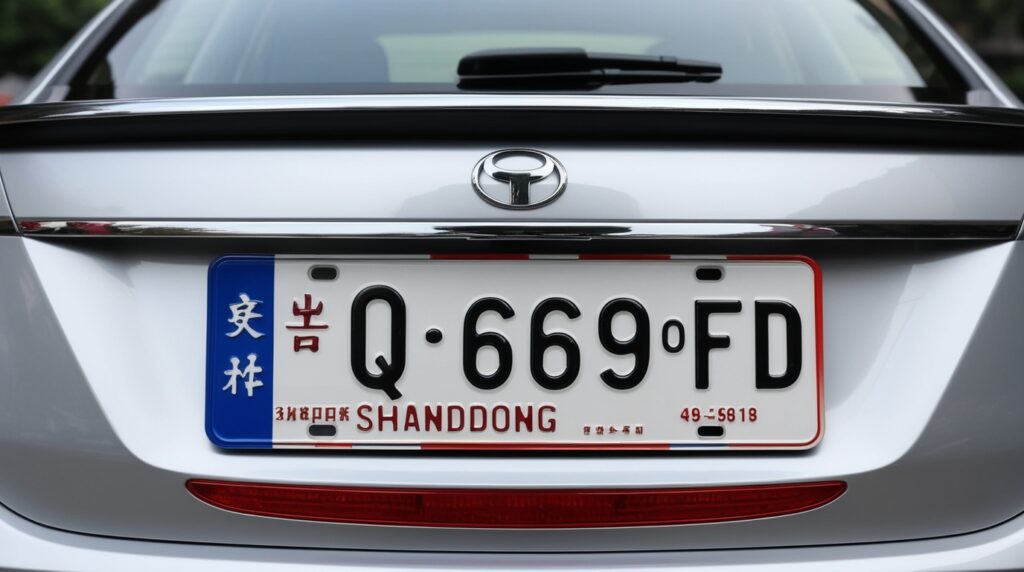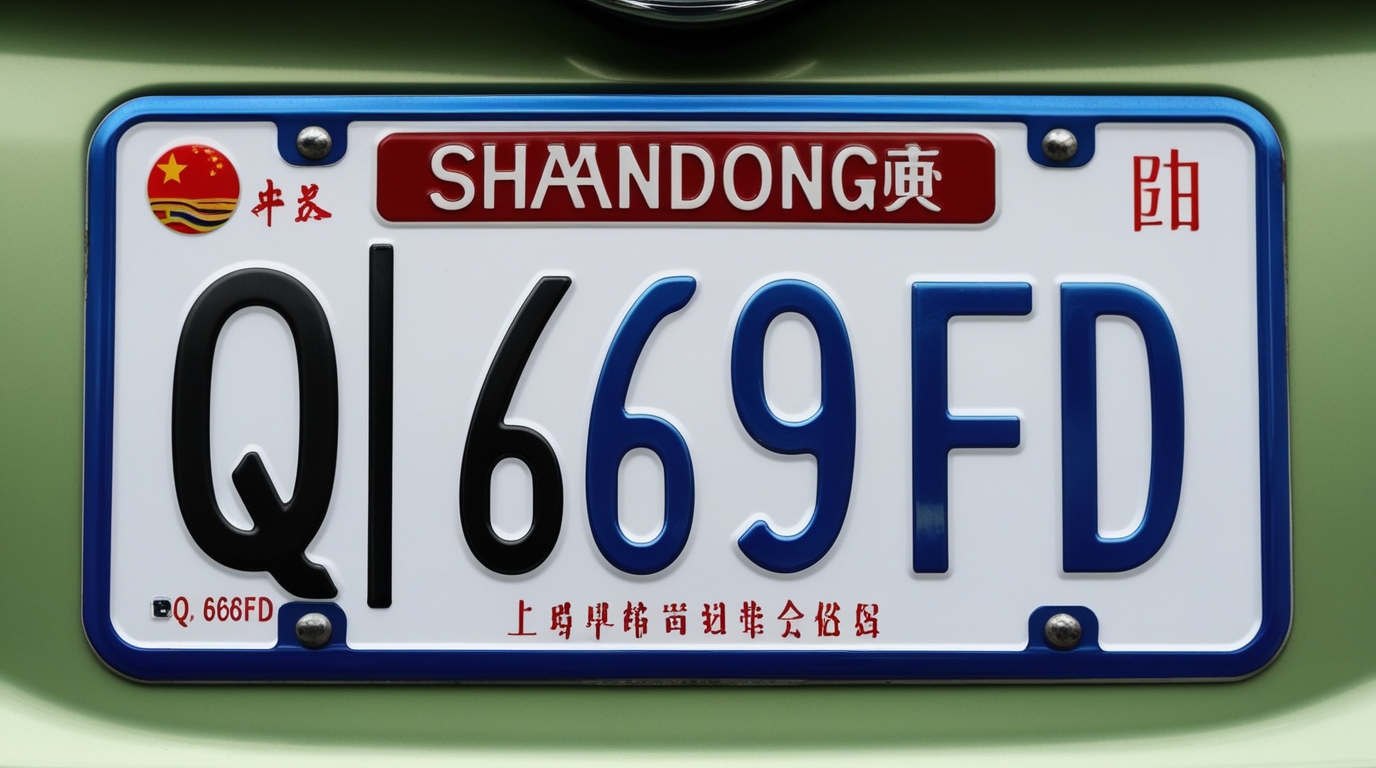The world of vehicle registration in China is as vast and complex as the country itself. Each region of China is designated a specific code for their license plates, reflecting both geographic and administrative designations. 鲁Q 669FD is a specific example of this, representing a car registered in Shandong Province, with its own unique features and implications. This article will delve into the details of the 鲁Q 669FD license plate, the significance of the “鲁” code, and provide insight into how Chinese vehicle registration works, alongside frequently asked questions.
What Does “鲁Q 669FD” Mean?

In China, vehicle license plates consist of a series of characters and numbers that include both a province code and a regional or city-based identifier. The first character of the plate, often a Chinese character, represents the province, autonomous region, or municipality where the vehicle is registered.
The Meaning of 鲁
The 鲁 character is the provincial code for Shandong Province, a large province located on the eastern coast of China, known for its rich history, economic development, and cultural significance. The character 鲁 is derived from the ancient state of Lu (鲁), which was the birthplace of Confucius and is thus highly regarded in Chinese history. The province is also famous for its traditional Chinese culture, Confucianism, and vibrant cities like Jinan (the provincial capital) and Qingdao (a coastal metropolis).
The “Q” in 鲁Q
Following the provincial character is a letter, which represents a specific city or region within that province. In this case, Q corresponds to a specific administrative division in Shandong. The lettered designation can represent a municipality or a district, and the usage of “Q” suggests a particular city within Shandong with its own system of vehicle registration.
What About the Numbers “669FD”?
After the 鲁Q, the following characters consist of numbers and sometimes letters. These provide more specific information regarding the vehicle’s registration number. In 鲁Q 669FD, the 669 is a specific identifier for the vehicle’s registration sequence within the Q region of Shandong. FD likely stands for further distinction within the specific series, such as vehicle type, ownership, or even vehicle category.
Shandong Province: A Key Region in China’s Vehicle Registration System
Overview of Shandong
Shandong Province is an important coastal region in China, which has a significant impact on the country’s economy and transportation systems. Its location along the Yellow Sea makes it a key player in China’s maritime industry, while its large population and advanced infrastructure continue to support the automotive sector. Shandong is home to several important cities, including Qingdao, Jinan, and Yantai, which are hubs of industry, culture, and tourism.
Shandong’s transportation system, including its vehicle registration practices, reflects the province’s strong economic growth. The vehicle registration system follows a well-organized process that is designed to streamline vehicle management across such a large and populous region.
Vehicle Registration in Shandong
China’s vehicle registration system is organized by province, and each province has its own method of assigning license plates. Shandong is no different, with its own set of registration rules and plate designations. Plates are often issued based on the province’s cities and districts, and Shandong, due to its size and economic significance, has multiple code prefixes like 鲁A, 鲁B, 鲁C, and others.
The Structure of Shandong’s Plates
Shandong plates typically start with the 鲁 character followed by a letter, then a set of numbers or letters, as exemplified in 鲁Q 669FD. The specific plate formats vary by city and district, with larger cities like Qingdao and Jinan having their own distinctive prefixes.
License Plate Format and Customs
The plate format in Shandong also follows a particular format for commercial, governmental, and private vehicles. While private cars follow the general format of 鲁+letter+numbers, commercial vehicles often feature additional characters or different letter combinations to signify their category or purpose.
Shandong’s Vehicle Culture and Trends
Car Ownership in Shandong
Shandong is home to a significant number of vehicle owners, especially in major cities like Qingdao, where economic development has led to a rise in car ownership. As the province has continued to grow, the number of vehicles registered here has also increased. This surge in vehicle numbers has made vehicle registration systems, such as the one reflected in 鲁Q 669FD, an essential aspect of urban infrastructure.
The people of Shandong often prefer a diverse range of vehicles, from affordable family sedans to luxurious cars and commercial vehicles. As the provincial capital, Jinan, grows in population and infrastructure, the demand for personal and business vehicles has continued to rise, influencing how license plates are assigned.
Shandong and Its Role in Chinese Car Manufacturing
Shandong also plays an important role in China’s automotive manufacturing industry. The province is home to several automotive manufacturers, contributing to the overall growth of the Chinese car market. The presence of these manufacturers, combined with the rise in car ownership, ensures that vehicle registration in Shandong, such as 鲁Q 669FD, remains an important part of the province’s economy and growth.
FAQs about 鲁Q 669FD and Shandong License Plates
1. What is the significance of the “Q” in the 鲁Q 669FD plate?
The Q in 鲁Q 669FD signifies the specific city or administrative district within Shandong where the vehicle is registered. Each letter corresponds to different regions within the province.
2. Why does Shandong use “鲁” as its provincial code?
The character 鲁 represents Shandong Province and comes from the historical state of Lu (鲁), which is notable for being the birthplace of Confucius. It is a significant cultural and historical symbol for the province.
3. How do I get a vehicle registration plate in Shandong?
To get a vehicle registration plate in Shandong, you need to follow the local vehicle registration procedures. This includes providing identification, proof of residence, and vehicle-related documents to the local vehicle management department.
4. Are there different vehicle types that get different plates in Shandong?
Yes, Shandong has different license plate types depending on the vehicle’s use. Commercial vehicles, for example, may have a different plate format than private vehicles, with additional characters indicating their purpose.
5. What does the number sequence “鲁Q 669FD” on the plate signify?
The number and letter sequence, 鲁Q 669FD, are part of a registration series unique to the vehicle’s specific location and registration sequence within Shandong’s vehicle registration system.
6. How can I tell where a car is from in China?
You can determine where a car is from in China by looking at the first character of the license plate, which corresponds to the provincial code. For example, 鲁Q 669FD represents Shandong Province, and the subsequent characters will provide more specific information about the vehicle’s registration.
7. How does Shandong manage its vehicle registration system?
Shandong, like other provinces in China, manages vehicle registration through a set of strict protocols and local vehicle management departments that ensure all vehicles are registered, taxed, and monitored according to national and provincial laws.
8. Can I transfer a vehicle from Shandong to another province?
Yes, it is possible to transfer a vehicle from Shandong to another province in China, but the process involves transferring the registration, paying the necessary fees, and ensuring the vehicle meets the requirements of the new province’s registration rules.
Conclusion
The 鲁Q 669FD license plate serves as a microcosm of the larger vehicle registration system in Shandong Province. It reflects not only the province’s rich cultural heritage but also its modern infrastructure and role within China’s booming automotive sector. Understanding the components of this unique plate sheds light on how Shandong fits into the broader context of vehicle registration and automotive culture in China.










